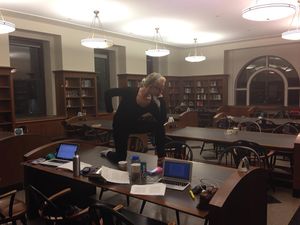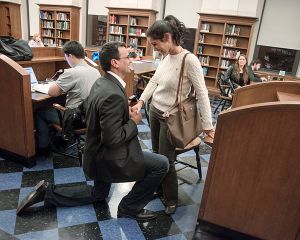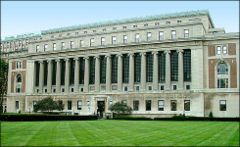Butler Library
Butler Library is Columbia's main library for undergraduate study and graduate research. It is named for longtime University President Nicholas Murray Butler, and holds 2 million volumes in the humanities. Butler has study rooms open 24 hours a day during the school year. Students in Butler tend to either work or procrastinate on their phones and laptops. Among its many facilities, Butler has a Blue Java outlet, a lounge (often used by students working on group assignments), and several computer labs.
Contents
History
Construction on Butler was begun in 1931 and the dedication ceremony was held in 1934. It was built in response to a space crunch at Low Library, which after 30 years had become too small to hold Columbia's growing collection. Discussions for a new library began in 1927 when the university librarian addressed a 13 page letter to President Butler proposing to build a new library by connecting Low Library to University Hall. When that proved unfeasible, James Gamble Rogers (the favored architect of donor Edward S. Harkness) was asked to execute a design for the 114th street border of the campus instead. The building was originally named South Hall, before being named in honor of Butler. It is said that there was a move to name the library after Columbia's 10th president, Frederick A. P. Barnard, but Butler put the kibosh on the idea, leaving the building strategically unnamed until his own retirement. This probably worked out well in the end: Columbia's main library being named "Barnard" would have only caused the Columbia-Barnard relationship to be more confusing than it already is.
Names on the facade
One of the more recognizable features of Butler Library's exterior is the list of names that wrap around the building. A common misconception is that the names represent authors featured in the Core Curriculum. The names were in fact hand-picked by President Nicholas Murray Butler when the building was designed[1], before there was much of a core curriculum. Besides, college students weren't even allowed in Butler for many years, which was geared to serve the research efforts of graduate students and faculty members. Of the 18 names engraved though, only Demosthenes has never been required reading in the history of the Core.
- Front: Homer, Herodotus, Sophocles, Plato, Aristotle, Demosthenes, Cicero, Vergil
- West (opposite Carman Hall): Horace, Tacitus, St. Augustine, Dante
- East (opposite John Jay Hall): Cervantes, Shakespeare, Milton, Voltaire, Goethe
Read from the Homer all the way around to Goethe, the names are roughly in chronological order.
In addition to the 18 prominent wrap-around names, each of the main windows on the campus side of the building except for the center three have two names inscribed underneath them. The three middle windows have a version of the university seal underneath them.
The names to the left of the seal are prominent early American politicians: George Washington, Benjamin Franklin, John Adams, Thomas Jefferson, Alexander Hamilton, John Jay, James Madison, John Marshall, John Quincy Adams, Henry Clay, Daniel Webster, and Abraham Lincoln.
The names to the right of the seal include prominent American writers: Jonathan Edwards, Washington Irving, James Fenimore Cooper, William Cullen Bryant, Ralph Waldo Emerson, Nathaniel Hawthorne, Henry Wadsworth Longfellow, Edgar Allan Poe[2], Henry David Thoreau, Herman Melville, Walt Whitman, and Mark Twain.
The names have been the subject of protest for much the same reason that students often protest the Core Curriculum: they are almost exclusively old, dead, white males. In the past, student activists have climbed to the Butler roof and unfurled banners covering the names with those of black or female authors instead.
Milstein Library
Butler is also home to the Phillip L. Milstein Family College Library which is the official designation for the 24-hour reading rooms and the collection of books stored within on the 2nd, 3rd, and 4th floors of the library. Since Milstein isn't really distinguishable from Butler itself in any major fashion, no one actually uses the term "Milstein," and most probably don't even know that it "exists". After 11pm, when the other rooms of the library close, graduate students come down from other floors and overcrowd the 24-hour reading rooms.
Books in the Milstein Library are organized by the first two letters in their call numbers:
| Call Number | Room Number |
|---|---|
| A - BL | 202 |
| BM - DJK | 209 |
| DK - DS 684 | 210 |
| DS 685 - E 185.86C | 2M11A (210 Mezzanine) |
| E 185.86 D - E ends | 212 |
| F - GV | 303 |
| H - HF 1418 | 303A |
| HF 1419 - HZ | 3M04 (303A Mezzanine) |
| J - PQ 2081 A | 403 |
| PQ 2081 B - PQ 6138 | 406A |
| PQ 6144 - PS 1855 | 406 |
| PS 1856 - ZA | 409 |
Facilities
- Lockers: enter the lottery every year at http://www.columbia.edu/cu/lweb/indiv/butler/lockers/.
- Photocopiers: on every floor.
Floor 2 (exit level)
Stacks Level 3
- Blue Java Butler coffee bar.
- 214: the lounge, the only place you can eat and talk. Colloquially known as ButCaf.
- 213: CUIT computer lab.
- Butler Reserves Desk
- 209-212: Milstein 24 hour undergraduate reading rooms.
- Undergraduate lockers
Floor 3
Stack Level 6 - the main stacks entrance
- Circulation and Reference desks
- 301: The Lawrence A. Wien Reference Room
- 310: Old card catalog room, future Digital Humanities Center
- Milstein 24 hour undergraduate reading rooms
- 305: Current Digital Humanities Center. Scanners and such.
Floor 4
Stack Level 8
- 401: Periodicals and Microforms reading room
- 403-409: Group study rooms
- Milstein 24 hour undergraduate reading rooms
Floor 5
Hours are the same as the circulation desk, meaning these reading rooms close!
- Administrative offices
- 502-504: "graduate" reading rooms
- Graduate lockers
Floor 6
Hours are the same as the circulation desk, meaning these reading rooms close!
- Rare Books & Manuscript Library. Including the Columbia Archives.
- CUIT Ninja printers in 606
- Graduate reading rooms, some with a fantastic view of Low Plaza
Floor 7
- Assigned graduate study carrels.
Floor 8
- Assigned graduate study carrels. Often empty and usable, as long as you stay quiet
- Oral History Collection
Floor 9
- Secret bathrooms
- Assigned graduate study carrels/offices. Generally locked.
Butler culture


- Butler tends to be pretty quiet and studious, with the exception of regularly scheduled events (like Orgo Night) or pranks like the famous "Library Musical" and "Powerbook Startup" sketches by Prangstgrüp.
- People tend to stick to their own preferred reading rooms, and entire social networks develop around these after a time, particularly on the fourth floor.
- Social connections forged in Butler have sometimes gone so far that students supposedly make out and go so far as to have sex in the stacks. No one has ever seen this actually happen, though people talk about it [5].
- Butler inspired the creation of Ref Spotting @ Columbia, a Facebook group revolving around Butler 301, also known as the Reference Room. Students take pictures of their friends studying in Ref to either shame or encourage them, typically late at night.
- Inspired the notorious anonymous chat room site Boredatbutler.com for "studying" students to vent online while there.
Camping out in Butler
During midterms and finals many people camp out in Butler. They take up valuable desk space and seats, leaving their books, laptops and other possessions in the library for extended periods. Some people even leave their belongings in the library 24 hours per day, usually to reserve the very best library real estate. A very small number of people literally camp out in Butler, sleeping there. This behavior can get all the crazier at Columbia because, unlike other university libraries, Butler is open 24/7, regardless of whether finals are taking place.
Butler Clearance Task Force
Many students believe that people who leave their belongings in Butler for extended periods are making unfair use of the library. As a remedy, objecting students believe that unattended belongings should be confiscated at regular intervals by library staff. The belongings would naturally be made available somewhere else in the library for students to claim. Alternatively, CCSC and the other class councils could do something useful for students by organizing a "Butler Clearance Task Force".
Tunnel/roof connections
Low Library
Main article: Butler to Low tunnel
Butler Library basement
Go down to the bottom of the X staircase (NW corner of Butler). It is a large basement which is mostly empty but has storage rooms. It is well lit and all-white. Frequent Benoit tags here. There are no cameras or alarms here, but there is a security gate in the staircase. It is trivial to open. Bring a screwdriver or the tunneler's friend, the swiss army knife. Beware constant staff intrusions during the daytime since the first floor of the stacks is used for book storage and the 'B' level of the non-stack area is frequented by maintenance workers. There is nevertheless a light security risk and a half-hearted security attempt.
Note that there is a tag for vecular@yahoo.com in the basement, an email that has been spotted in about 3 places. The email address is non-responsive, but doesn't bounce back.
The machine room in the southwest corner of the building is fun. You can get out into an exhaust plenum which has vents opening to the outdoors. Some are large enough to climb through. You'll find yourself under a set of grates which are part of the sidewalk on the 114th street side of Butler.
- Note* The Security Gate has been altered, and while it can still be opened, it takes considerably more effort. Try pulling the gate back while pushing the deadbolt in with a screwdriver. It may take a few tries, but it is possible.
Carman Hall
Go down to the basement, and go to the southwest corner. You will see the padlocked double doors. These are normally inaccessible, but as of 6/06, the double doors are unlocked, so the passage between Butler and Carman/Lerner is wide open.
John Jay Hall
Go to the east edge of the basement. You will see a locked door with sharpie markings on it, possibly welded/hot glued shut. It leads into part of the JJ's store room.
The John Jay/Butler/Carman tunnels were once used to transport food from John Jay Dining Hall to the Lion's Den cafeteria in Ferris Booth Hall.
Alumni access
Alumni get free access to Butler for life.[6] They'll give you a functioning Columbia alumni ID which last for a ridiculously long time (10 years) before they have to be renewed. Borrowing privileges, on the other hand, are $30 a month.
Photos
Butler Library basement level, circa 1940. It is still fairly accurate, shows the tunnel to John Jay Hall and a future tunnel to what will be Carman Hall. Note there is no tunnel in the direction of Low Library. You can see the X staircase and the stack staircases/elevators. "Stereoptician" should be spelled "stereopticon", which was a device that was like a slide projector.
External links
- Butler Library Homepage
- A Library for the Twentieth Century: The Rise of South Hall
- Butler Library Self Guided Tour
- "The Definitive Guide to Butler Sex", from the The Blue and White in 2006
References
- ↑ The Writing Is on the Wall: Who Is Demosthenes, Anyway?
- ↑ Coincidentally, Columbia's been hiding the mantel from the apartment where Poe wrote The Raven in storage for over 100 years. After scoring it by promising to display it publicly. Currently it's located on the mezzanine of the RBML and you have to ask to see it. Lesson: never donate anything to Columbia.
- ↑ http://www.reddit.com/r/columbia/comments/1c4gng/i_conquered_butler_409_its_4am_on_wednesday_the/
- ↑ http://www.nytimes.com/2013/06/16/fashion/weddings/upon-closer-examination-its-love.html?_r=1&
- ↑ http://bwog.com/2010/09/01/the-definitive-guide-to-butler-sex-2/
- ↑ Library Access for Alumni
| Columbia University Libraries |
| Avery (Architecture & Fine Arts) • Business & Economics • Butler • Engineering • Geology • Geoscience • Health Sciences • Journalism • Law School • Lehman Social Sciences • Mathematics Library • Music & Arts • Science & Engineering • Social Work • Starr East Asian |
| Affiliated Libraries |
| Barnard College • Burke (UTS) • Jewish Theological • Teachers College |
| Special Collections and Programs |
|
Digital Humanities Center (formerly Electronic Text Service) • Digital Social Science Center • Oral History Research Office • Rare Book & Manuscript • University Archives |



